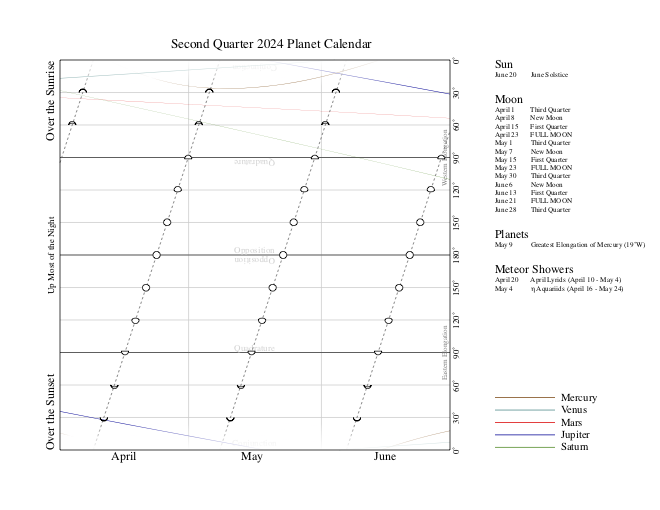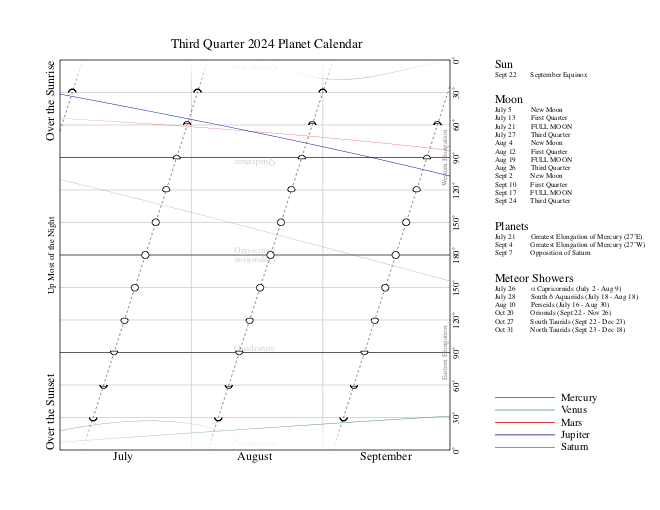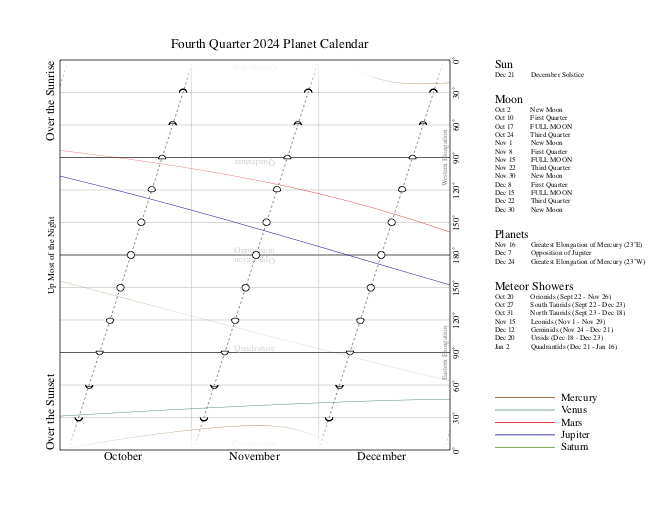Planet Calendars
Charts showing where to look for the planets in the sky.
As a science teacher, I always wanted my students observe celestial objects in their own sky over their own neighborhood whenever possible. I especially liked to have students observe planets over the sunset. Children and families are often out and about around dinnertime anyway, and sunsets decorated by the moon and planets are very pretty. Furthermore, observations like these are how you figure out what's going on in outer space. Observations like these provided the first clues that ancient and Enlightenment scientists used to figure out what our home world and our neighborhood in space are like.
The trouble with trying to point out planets to children is that each planet follows its own irregular schedule. If you want to know ahead of time where planets will be, you can use software such as Stellarium to show you what the sky will look like at any given time from any given location, but I didn’t like having to remind myself all the time to check my software. I wanted a calendar that would show me at a glance what is coming up in the next few weeks and months. So I made these “Planet Calendars.” They show which planets will be over the sunset, which will be over the sunrise, and which will be high in the night sky, for a few months or years in advance.
Reading the Charts
The charts are technically plots of “elongation angle” versus time. The elongation angle is a measure of how far a planet (or the moon) is from the sun in the sky. To be more precise, it is the angle separating the sun and the planet, from the perspective of someone on Earth, measured in degrees. The horizontal axis in these charts is time, progressing from left to right, with the months and years labeled. The vertical axis is the elongation angle.
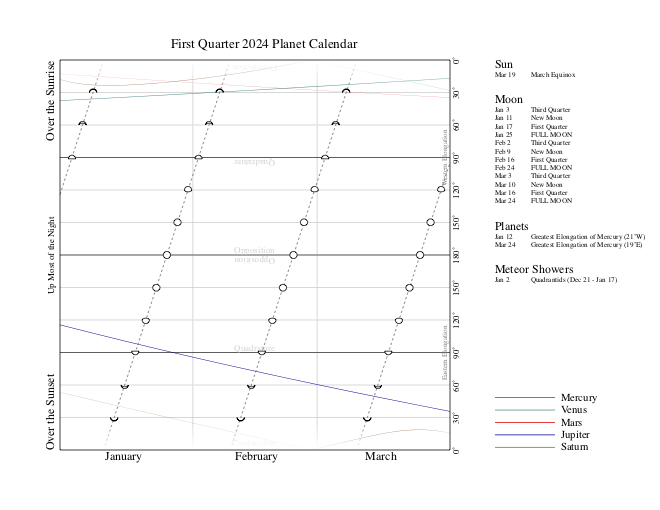
When a planet crosses the top or bottom of the chart, it has an elongation angle of zero, meaning it is right next to the sun in the sky, and is not visible. (When this happens, we say the planet is “in conjunction.”) When a planet is near the bottom of the chart, it has a small elongation angle, meaning it is close to the sun in the sky, and it will be visible over the sunset. If you imagine the bottom edge of the chart as the horizon, and the area above it as the sky, then the curves in the lowest section of the chart represent the planets visible over the sunset on that date, and their distance from the lower edge will represent roughly how high they are in the sky over the horizon.
When a planet is near the top of the chart, it also has a small elongation angle and is near the sun, but it is on the other side of the sun, meaning that it will be visible over the sunrise. If you turn the chart upside down, and imagine the bottom edge (which used to be the top edge) as the horizon, the curves in the lowest section of the chart will represent the planets visible over the sunrise on that day.
When a planet crosses the centerline in the middle of the chart, it has an elongation angle of 180°, and it is on the opposite side of us from the sun. It will rise in the east just as the sun sets in the west, it will be high in the sky in the middle of the night, and it will set in the west just as the sun comes up in the east. When this happens, we say the planet is “at opposition,” and interesting things happen whenever something is at opposition. When the moon is at opposition, it is full. Venus and Mercury can never be at opposition, because they are trapped near the sun, and are only ever visible over sunrises and sunsets. When Mars, Jupiter, or Saturn is at opposition, it will get brighter — dramatically so for Mars, but not so much for the others — and it will also reverse itself compared to the stars and move backwards through the zodiac for a little while. (We call this “retrograde motion.”)
When a planet has an elongation angle of 90°, this means that it is a quarter-turn from the sun in the sky, like the first and third-quarter moons. (When this happens, we say that the planet is “at quadrature.”)
Without a telescope, there are five “visible planets” that we can see in the sky, and they appear to us in the sky just like stars, except they move. They creep gradually through the proper constellations. (The name “planet” derives from a Greek word meaning “wanderer” or “wandering star.”) Also like stars, different planets have different levels of brightness. Jupiter and Venus are brighter than any of the “normal” or “fixed” stars, and are usually very easy to find in the sky. Mercury and Saturn are fairly dim, and Mars varies dramatically, from as dim as Saturn to as bright as Jupiter. In my charts, I tried to scale the thicknesses of the curves to represent the brightness of the planet. When a planet is bright, its curve is thick and easy to see. When a planet is dim, its curve can sometimes be a bit thin and hard to see, but this means that the planet will be more difficult to find in the sky as well.
Dates and Events
A few notes about the list of events:
Please note that I do NOT include dates of eclipses, so you will still have to check for those separately. It would also be interesting to know when two planets, or a planet and the moon, will be close together in the sky, but I haven’t worked out a detailed search algorithm for that yet, either. However, you can get a pretty good idea of when planets will be close together in the sky by noticing where their curves of location cross each other in the charts.
I am pretty confident that my calculations for solstices, equinoxes, and moon phases are accurate to within an hour or less. However, the dates I give are in Greenwich Time, so depending on your time zone, and how close the event is to midnight, they might occur on your calendar one day before or after the date I give.
For planetary events, I chose to list oppositions and maximum elongations, but not quadratures or conjunctions. Dates of “maximum elongation” are the times when Venus or Mercury stops moving farther away from the sun in the sky, reaches its greatest distance from the sun, and turns around and moves towards the sun again. The days near to these dates are the best times to look for Venus or Mercury. This is when they will be highest over the sunrise or sunset.
Meteor showers are somewhat irregular and difficult to pin down. The single dates listed correspond to the historical peaks of activity, and the date ranges listed correspond to historical first and last-observed meteors attributable to their respective showers.
Characteristic Behavior
Notice that the four-year calendar makes very clear some characteristic behavior of each of the planets. Mercury and Venus are both trapped near the sun, and their “way of life” is to oscillate back and forth between being a sunrise star and a sunset star. Mercury is relatively dim, and is trapped closer to the sun — it is always within about 28° from the sun, and always less than 28° above the horizon — making it arguably the hardest-to-find visible planet. Venus is also trapped near the sun, but can be much farther away, up to about 47° from the sun, and thus can be much higher over the sunrise or sunset.
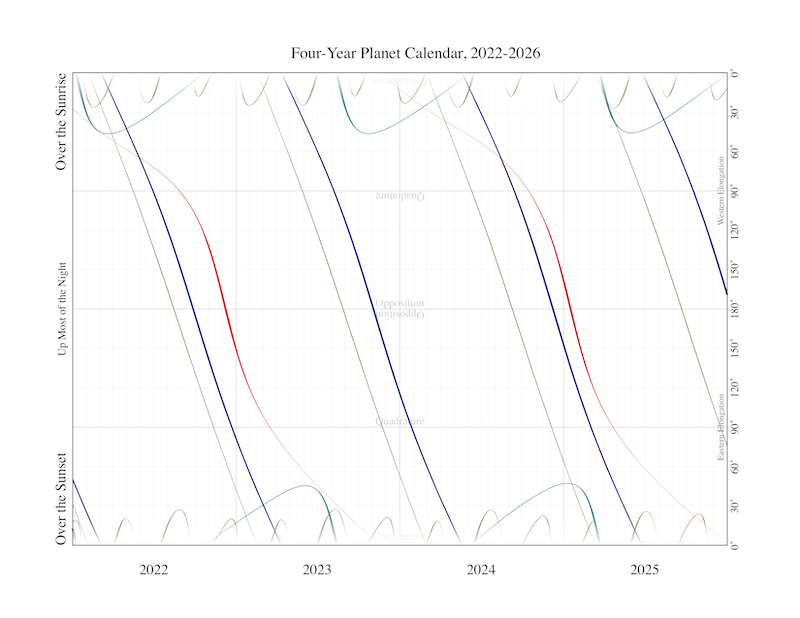
The three other visible planets — Mars, Jupiter, and Saturn — are not trapped near the sun, and unlike Venus and Mercury can be high overhead in the night sky. Jupiter and Saturn march very regularly compared to the sun, more or less in steady circles, in a manner similar to the moon, lapping the sun in the sky every year or so. Mars behaves similarly, but more irregularly, taking around 2 years to complete its cycle, and dramatically speeding up and getting brighter every time it is near opposition.
These repeating cycles of planetary behavior could be called “synodic cycles,” although judging by a Google search, that term now appears to have been taken over by astrology. The length of time it takes a planet to complete the cycle, however, is still called the “synodic period.”
| Planet | Synodic Period |
|---|---|
| Mercury | 0.3 Years (About 4 Months) |
| Venus | 1.6 Years |
| Mars | 2.1 Years |
| Jupiter | 1.1 Years |
| Saturn | 1.0 Years |
Saturn has a synodic period that is greater than a year by about two weeks, and the telescopic planets Uranus and Neptune have synodic periods that are only a few days longer than a year.
